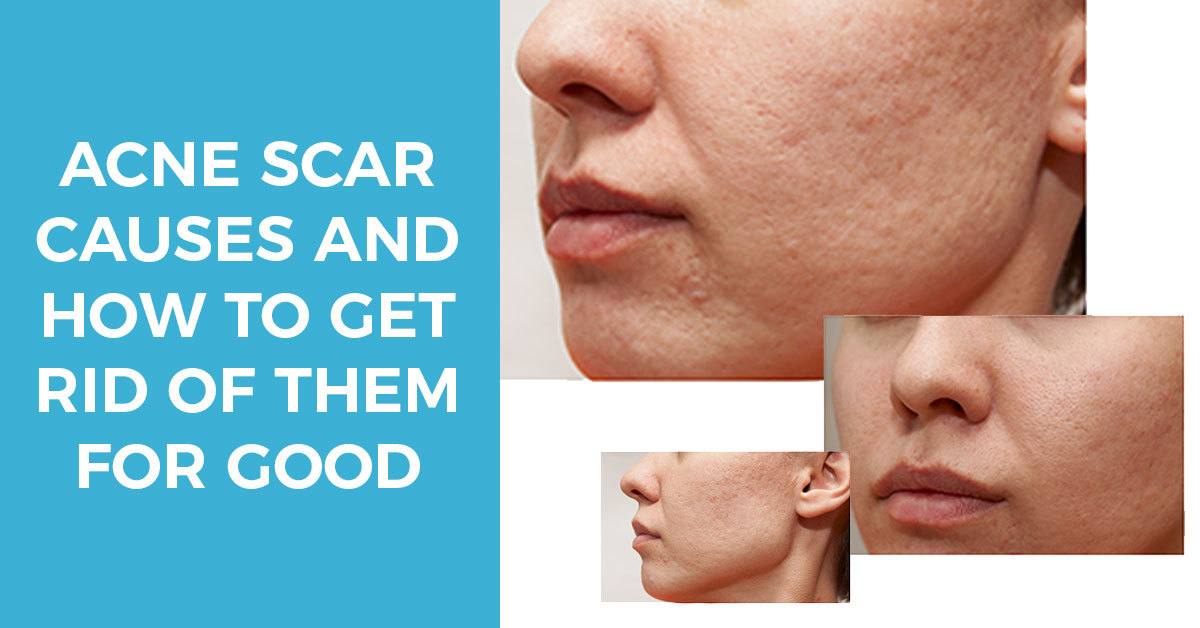Contents
According to statistics, every 3 out of 4 people aged 11-30 suffer from acne, which makes it probably the most widespread skin disease in the world. While acne isn’t dangerous it does affect our social life and self-esteem in a way that is a real pain to deal with on a daily basis.
Moreover, as if acne itself wasn’t bad enough, some of the more painful ones tend to leave a scar when they are gone. Luckily, modern medicine offers a variety of ways that can treat acne scars. Today we will explore acne scars in detail, find out their causes, how to prevent acne scars and how to combat it.
What are Acne Scars?
Acne scars are the result of damage caused to skin cells by acne. While some types of acne can cause scarring on their own, external factors such as picking and squeezing even the smallest pimples can result in skin tissue damage, ultimately leaving you with a scar after the acne is gone. Most commonly, acne scars acquire the shape of pitted or raised skin and can occur on both the face and body.
A lot of the times acne scars are confused with post-acne marks such as hyperpigmentation or redness. This is especially true for dark skin types since those marks are brown colored, which makes them very noticeable on the dark skin. Unlike acne scars, post-acne marks, in the vast majority of cases, are temporary and go away with time (around 6 months), or with relatively easy treatment methods. Acne scars, on the other hand, are permanent and do not heal overtime or go away with the help of OTC methods, and require a more complicated healing procedure to get rid of.
What Causes Acne Scars?
While the main cause of scarring is acne, the actual formation of the scars is the natural, regenerative process of the skin, which is trying to heal itself after damage. As the skin pores get clogged with environmental dust, debris and excess oil, creating a favorable atmosphere for bacteria to breed, acne lesions begin to get formed.
The more painful and big lesions are typically formed in the deep layers of the skin as opposed to the smaller ones that are superficially located. After the rupture of these lesions, the mass inside them gets spilled on the surrounding skin tissue and inflicts permanent damage. In response, your body produces collagen fibers in an attempt to replace damaged skin cells with new, healthy ones, but sometimes, the amount of collagen produced is too little or too much, which results in various types of scars.
Which Acne Typically Cause Scarring?
In general, the deeper the acne lesions are located inside the skin, the higher the chance to leave a scar. For example, whiteheads and blackheads are located superficially and rarely cause scarring, while painful cysts and nodules are located deep inside the skin and most commonly result in a scar. A huge factor that facilitates scarring is picking and squeezing the pimples, increasing poor collagen formation chances dramatically.
What Makes You Prone to Acne Scarring?
Picking and squeezingThere are a number of things that can influence scarring mechanisms:
Genetics
Late treatment/absence of treatment
Skin Type
Picking and squeezing
There are 5 common types of acne scars:
- Atrophic scars – Due to the loss of skin tissue and too little collagen produced to replace it, this type of scars typically create a pitted or pockmarked spots on your face.
- Ice picked scars – these are very narrow and deep acne scars, which formed as a result of the rupture of acne lesions deep inside the skin. Due to the little amount of collagen produced by the body, ice picked scars have pitted appearance as if the skin has been stabbed by ice picks. They are also the hardest to get rid of.
- Boxcar scars – This type of pitted scars are round or oval shaped and generally a lot wider than ice picked scars. They, too, are formed due to inefficient amount of collage produced by the body as a response to injury.
- Keloid scars – Keloid scars are the result of too much collagen produced at the rupture site and they typically have a raised appearance. Those are the least common type of acne scars.
- Rolling scars – Rolling scars are another type of pitted scars and look like a pattern of slightly raised and slightly depressed skin areas.
While there is no way to prevent acne scarring for good, the following steps will help minimize the chance to be left with a scar:
- Treat acne as soon as possible – Treating acne with OTC methods, such as spot treatment products containing salicylic acid and benzoyl peroxide, will help reduce inflammation and minimize the chance for cysts to damage your skin when they rupture. Consult a professional if your acne isn’t getting better with OTC methods.
- Don’t pick at scabs – When acne is healing, just like any other wound, it gets covered by a scab. The scabbing is a part of the natural healing process and picking at scabs makes the skin vulnerable, increasing the chance of poor collagen formation.
- Don’t touch your face – Avoid touching your face as much as possible, especially when you’re outside, at work, etc. The environmental debris can easily travel from your fingertips to face pores, clogging them even further and increasing the chance of developing acne.
- Understand your skin type – The thing is that some people are more prone to developing acne scars than others. If you have large, deep pores and oily skin, you need to be extra careful around your acne.
- Know what products you are using – When treating acne, it’s important to know what you’re doing. Some products may be too aggressive for your skin type or contain ingredients that can irritate or inflame your skin. You want to avoid those.
There are various ways to treat acne scars, including natural methods. The right method should be chosen based on your skin and scar types, and the severity of the case. The time required to get rid of scars also depends on those factors – for example, atrophic scars take less time to heal completely compared to ice pick scars, which take the longest due to them being really deep inside the skin.
All types of healing mostly do the same thing using different means:
- Peeling a layer of the skin and allowing it to regenerate, and repeating the process until the scars are no longer there.
- Filling the depressed skin areas with materials that help smooth and rejuvenate the skin from within.
Chemical peels – A strong, acid-based solution is applied to the skin, covering either the entire face or just the areas that are scarred, removing a layer from the skin and stimulating repair. The number of sessions needed depend on the severity of the case.
Dermal fillers – Injectable hyaluronic acid containing products such as Juvederm and Restylane, can be used to fill pitted skin areas to smooth the overall appearance. The downside is that dermal fillers offer temporary solutions (the mass usually dissolves after 4-6 months) and need to be re-injected continuously to maintain the results.
Laser resurfacing – Pixelated laser heat is delivered into the skin to either heat it and allow the collagen to reshape or remove skin layers and allow skin to regenerate. The number and type of sessions varies from case to case.
CONCLUSION
Throughout this article we’ve provided you with a lot of information on what you should put on your skin and what those things will do for your it.
We’ve also discussed what things you really shouldn’t use and what they will do to your skin if you do. Between all this and the breakdown of why blackheads form, we’ve given you a lot of information to sort through.
Therefore, we’d like to close out by streamlining your focus into a central idea that you should put at the core of your skincare routine. Whatever type of skin you have, no matter how much money you have in your skincare budget, your main goal is to avoid irritating your skin.
Skincare is a very deep subject and even an article just on blackheads has this much information. But all of the flood of skincare options are just different ways to reach the same goal; preventing irritation of your skin. Irritation leads directly to inflammation which, (one last time), is the core cause of all types of acne.
The art of skincare ultimately breaks down into two stages. The first stage is to tackle any irritation or inflammation you currently have and return your skin to the healthiest state possible.
Once you’ve achieved the blackhead free, unblemished skin you’ve always wanted, your priority shifts to maintaining this state of affairs. So, make use of the information in this article and, once again, please don’t smear toothpaste on your face. It REALLY won’t help you at all.



